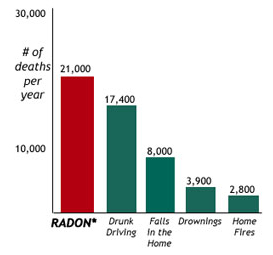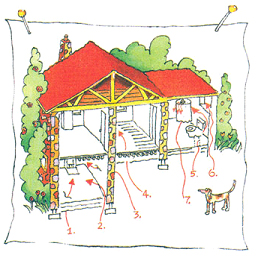The Importance of Basement & Crawl Space Waterproofing
Health and Safety Concerns
Radon
Found in high concentrations throughout Chicagoland, radon gas is known to cause a variety of health problems including allergies and cancer. Ask Accu-Dry how you can have your Radon level checked for a safer, better life.
If you are seeing water leaking through a crack, say after a good rain, you have a potentially serious problem. Please let us know, in detail, what you see when you fill out our Request Form. There are many instances, where we can take care of things at a low cost. On the other hand, if you wait, these small cracks and the water damage that we can’t see can become huge costly problems.
Radon is a cancer-causing, radioactive gas
You can’t see radon. And you can’t smell it or taste it. But it may be a problem in your home.
Radon is estimated to cause many thousands of deaths each year. That’s because when you breathe air containing radon, you can get lung cancer. In fact, the Surgeon General has warned that radon is the second leading cause of lung cancer in the United States today. Only smoking causes more lung cancer deaths. If your home has high radon levels, your risk of lung cancer is especially high.
Radon can be found all over the U.S.

Radon can be found all over the U.S. It can get into any type of building – homes, offices, and schools – and result in a high indoor radon level. But you and your family are most likely to get your greatest exposure at home, where you spend most of your time.You should test for radon.
Testing is the only way to know if you and your family are at risk from radon. EPA and the Surgeon General recommend testing all homes below the third floor for radon. EPA also recommends testing in schools.
Testing is inexpensive and easy – it should only take a few minutes of your time. Millions of Americans have already tested their homes for radon (see http://4crawlspaces.com/).
1-800-SOS-RADON (1-800-767-7236)
Operated by the National Safety Council in partnership with EPA to order radon test kits
Radon Gets in Through:
- Cracks in solid floors
- Construction joints
- Cracks in walls
- Gaps in suspended floors
- Gaps around service pipes
- Cavities inside walls
- The water supply
What Your Test Results Mean
The average indoor radon level is estimated to be about 1.3 pCi/L, and about 0.4 pCi/L of radon is normally found in the outside air. The U.S. Congress has set a long-term goal that indoor radon levels be no more than outdoor levels. While this goal is not yet technologically achievable in all cases, most homes today can be reduced to 2 pCi/L or below.
Sometimes short-term tests are less definitive about whether or not your home is above 4 pCi/L. This can happen when your results are close to 4 pCi/L. For example, if the average of your two short-term test results is 4.1 pCi/L, there is about a 50% chance that your year-round average is somewhat below 4 pCi/L. However, EPA believes that any radon exposure carries some risk – no level of radon is safe. Even radon levels below 4 pCi/L pose some risk, and you can reduce your risk of lung cancer by lowering your radon level.
If your living patterns change and you begin occupying a lower level of your home (such as a basement) you should retest your home on that level.
Even if your test result is below 4 pCi/L, you may want to test again sometime in the future.
Zone 1: Highest Potential
counties have a predicted average indoor radon screening level greater than 4 pCi/L (picocuries per liter) (red zones)
Zone 2: Moderate Potential
counties have a predicted average indoor radon screening level between 2 and 4 pCi/L (orange zones)
Zone 3: Low Potential
counties have a predicted average indoor radon screening level less than 2 pCi/L (yellow zones)
Any home may have a radon problem
Radon is a radioactive gas. It comes from the natural decay of uranium that is found in nearly all soils. It typically moves up through the ground to the air above and into your home through cracks and other holes in the foundation. Your home traps radon inside, where it can build up. Any home may have a radon problem. This means new and old homes, well-sealed and drafty homes, and homes with or without basements.
Radon from soil gas is the main cause of radon problems. Sometimes radon enters the home through well water. In a small number of homes, the building materials can give off radon, too. However, building materials rarely cause radon problems by themselves.
For further information:
EPA: https://www.epa.gov/radon
Or CALL: 630-663-4598
It’s never too late to reduce your risk of lung cancer.
Don’t wait to test, call Accu-Dry Basement Waterproofing & Concrete Crawlspaces today to fix your radon problem!
Mold
The key to mold control is moisture control. It is important to dry water-damaged areas and items within 24-48 hours to prevent mold growth. If mold is a problem in your home, clean up the mold and get rid of the excess water or moisture. Fix leaky plumbing or other sources of water. Wash mold off hard surfaces with detergent and water, and dry completely. Absorbent materials (such as ceiling tiles & carpet) that become moldy may have to be replaced.
Mold and mildew cause this damp, musty smell. These are musty-smelling fungi that thrive in moist conditions. Keeping humidity down reduces the chance for mold to grow. In general, mold will not grow at less than 50% relative humidity! Dehumidification is the key. Of course, any groundwater, plumbing, or other leaks should be fixed, as part of a strategy to eliminate mold.
Mold spores can certainly irritate someone with allergies. The number one allergen, however, is the fecal matter of dust mites. Dust mites don’t drink water but absorb it out of the air through their skin. In order to live, dust mites need relative humidity over 50%. Reducing the relative humidity below 50% will cause dust mites to die off.
Ten Things You Should Know About Mold
- Potential health effects and symptoms associated with mold exposures include allergic reactions, asthma, and other respiratory complaints.
- There is no practical way to eliminate all mold and mold spores in the indoor environment; the way to control indoor mold growth is to control moisture.
- If mold is a problem in your home or school, you must clean up the mold and eliminate sources of moisture.
- Fix the source of the water problem or leak to prevent mold growth.
- Reduce indoor humidity (to 30-60% ) to decrease mold growth by venting bathrooms, dryers, and other moisture-generating sources to the outside; using air conditioners and dehumidifiers; increasing ventilation; and using exhaust fans whenever cooking, dishwashing, and cleaning.
- Clean and dry any damp or wet building materials and furnishings within 24-48 hours to prevent mold growth.
- Clean mold off hard surfaces with water and detergent, and dry completely. Absorbent materials such as ceiling tiles, that are moldy, may need to be replaced.
- Prevent condensation: Reduce the potential for condensation on cold surfaces (i.e., windows, piping, exterior walls, roof, or floors) by adding insulation.
- In areas where there is a perpetual moisture problem, do not install carpeting (i.e., by drinking fountains, by classroom sinks, or on concrete floors with leaks or frequent condensation).
- Molds can be found almost anywhere; they can grow on virtually any substance, providing moisture is present. There are molds that can grow on wood, paper, carpet, and foods.
Asthma and Mold
Molds can trigger asthma episodes in sensitive individuals with asthma. People with asthma should avoid contact with or exposure to molds.
Learn More
EPA Mold: Resources and Learning
EPA Asthma: Management and Action
Allergy & Asthma Network/Mothers of Asthmatics (AAN/MA): (800) 878-4403
American Academy of Allergy, Asthma & Immunology (AAAAI)
American Lung Association: 1-800-LUNG-USA (1-800-586-4872)
Asthma & Allergy Foundation of America: (800) 7ASTHMA
Health and Mold
How do molds affect people?
Some people are sensitive to molds. For these people, exposure to molds can cause symptoms such as nasal stuffiness, eye irritation, wheezing, or skin irritation. Some people, such as those with serious allergies to molds, may have more severe reactions. Severe reactions may occur among workers exposed to large amounts of molds in occupational settings, such as farmers working around moldy hay. Severe reactions may include fever and shortness of breath. Some people with chronic lung illnesses, such as obstructive lung disease, may develop mold infections in their lungs.
Can mold cause health problems?
Molds are usually not a problem indoors unless mold spores land on a wet or damp spot and begin growing. Molds have the potential to cause health problems. Molds produce allergens (substances that can cause allergic reactions), irritants, and in some cases, potentially toxic substances (mycotoxins). Inhaling or touching mold or mold spores may cause allergic reactions in sensitive individuals. Allergic responses include hay fever-type symptoms, such as sneezing, runny nose, red eyes, and skin rash (dermatitis). Allergic reactions to mold are common. They can be immediate or delayed. Molds can also cause asthma attacks in people with asthma who are allergic to mold. In addition, mold exposure can irritate the eyes, skin, nose, throat, and lungs of both mold-allergic and non-allergic people. Symptoms other than the allergic and irritant types are not commonly reported as a result of inhaling mold. Research on mold and health effects is ongoing. This brochure provides a brief overview; it does not describe all potential health effects related to mold exposure. For more detailed information consult a health professional. You may also wish to consult your state or local health department.
It is impossible to get rid of all mold and mold spores indoors; some mold spores will be found floating through the air and in house dust. The mold spores will not grow if moisture is not present. Indoor mold growth can and should be prevented or controlled by controlling moisture indoors. If there is mold growth in your home, you must clean up the mold and fix the water problem. If you clean up the mold, but don’t fix the water problem, then, most likely, the mold problem will come back.
High Humidity
The source of your problem could be a water leak or high humidity. Both can lead to mold, mildew, or other biological growth. Depending on the severity, conditions can lead to rot, structural damage, premature paint failure, and a variety of health problems. Water can seep into your house from the outside through a leak in the foundation, or small gaps around windows or doors. Water can also come from inside your house from a leaking water pipe, toilet, shower, or bathtub. High indoor humidity caused by normal activities of everyday living, such as showering, cooking, and drying clothes, can also be a source of your problem. A damp basement is commonly caused by moisture migrating through a concrete foundation. There may not be a sign of any leak or standing water, but the moisture evaporates, increasing indoor humidity. Another common cause is condensation on the cold concrete walls and floors during humid months.
